Antenna tuner

| Part of a series on |
| Antennas |
|---|
 |
|
Common types |
|
Radiation sources / regions |
An antenna tuner, a matchbox, transmatch, antenna tuning unit (ATU), or antenna coupler is a device connected between a radio transmitter or receiver and its antenna to improve power transfer between them by matching the impedance of the radio to the antenna’s feedline. Similar matching networks are used in other equipment (such as linear amplifiers) to transform impedance.
An antenna’s impedance is different at different frequencies. An antenna tuner matches a radio with a fixed impedance (typically 50 Ohms for modern transceivers) to the combination of the feedline and the antenna; useful when the antenna’s feedline impedance is unknown, complex, or otherwise different from the transceiver. Coupling through an ATU allows the use of one antenna on a broad range of frequencies. However, despite its name, an antenna ‘tuner’ actually only matches to the antenna feedline – an antenna ‘tuner’ does not and cannot change the resonant frequency of the aerial.
Operating an antenna far from its design frequency and compensating with a transmatch is not as efficient as using a resonant antenna with a matched-impedance feedline. If there is still a high SWR (multiple reflections) in the feedline beyond the ATU, any loss in the feedline increases, heating the wire instead of sending out a signal. Additionally, losses in the ATU itself can also waste power.
Broad band matching methods
Transformers, autotransformers, and baluns are sometimes incorporated into the design of narrow band antenna tuners and antenna cabling connections. They will all usually have little effect on the resonant frequency of either the antenna or the narrow band transmitter circuits, but can widen the range of impedances that the antenna tuner can match, and/or convert between balanced and unbalanced cabling where needed.
Ferrite transformers
Solid-state power amplifiers operating from 1–30 MHz typically use one or more wideband transformers wound on ferrite cores. MOSFETs and bipolar junction transistors are designed to operate into a low impedance, so the transformer primary typically has a single turn, while the 50 Ohm secondary will have 2 to 4 turns. This design has the advantage of not requiring retuning when the operating frequency is changed. A similar design can match an antenna to a transmission line; For example, many TV antennas have a 300 Ohm impedance and feed the signal to the TV via a 75 Ohm coaxial line. A small ferrite core transformer makes the broad band impedance transformation. This transformer does not need, nor is it capable of adjustment. For receive-only use in a TV the small SWR variation with frequency is not a major problem.
It should be added that many ferrite based transformers perform a balanced to unbalanced transformation along with the impedance change. When the balanced to unbalanced function is present these transformers are called a balun (otherwise an unun). The most common baluns have either a 1:1 or a 1:4 impedance transformation.
Autotransformers
There are several designs for impedance matching using an autotransformer, which is a single-wire transformer with different connection points or taps spaced along the windings. They are distinguished mainly by their impedance transform ratio (1:1, 1:4, 1:9, etc., the square of the winding ratio), and whether the input and output sides share a common ground, or are matched from a cable that is grounded on one side (unbalanced) to an ungrounded (usually balanced) cable. When autotransformers connect balanced and unbalanced lines they are called baluns, just as two-winding transformers. When two differently-grounded cables or circuits must be connected but the grounds kept independent, a full, two-winding transformer with the desired ratio is used instead.
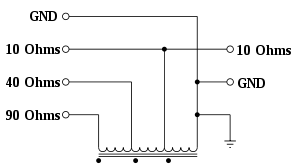
The circuit pictured at the right has three identical windings wrapped in the same direction around either an "air" core (for very high frequencies) or ferrite core (for middle, or low frequencies). The three equal windings shown are wired for a common ground shared by two unbalanced lines (so this design is called an unun), and can be used as 1:1, 1:4, or 1:9 impedance match, depending on the tap chosen. (The same windings could be wired differently to make a balun instead.)
For example, if the right-hand side is connected to a resistive load of 10 Ohms, the user can attach a source at any of the three ungrounded terminals on the left side of the autotransformer to get a different impedance. Notice that on the left side, the line with more windings measures greater impedance for the same 10 Ohm load on the right.
Narrow band design
Transmission line antenna tuning methods
The insertion of a special section of transmission line, whose characteristic impedance differs from that of the main line, can be used to match the main line to the antenna. An inserted line with the proper impedance and connected at the proper location can perform complicated matching effects with very high efficiency, but spans a very limited frequency range.[1]
The simplest example this method is the quarter-wave impedance transformer formed by a section of mismatched transmission line. If a quarter-wavelength of 75 Ohm coaxial cable is linked to a 50 Ohm load, the SWR in the 75 Ohm quarter wavelength of line can be calculated as 75Ω / 50Ω = 1.5; the quarter-wavelength of line transforms the mismatched impedance to 112.5 Ohm (75 Ohm × 1.5 = 112.5 Ohm). Thus this inserted section matches a 112 Ohm antenna to a 50 Ohm main line.
The 1/12 wavelength coaxial transformer [2] is a useful way to match 50 to 75 ohms using the same general method. A more theoretical discussion by the inventor and wider application of the method is found here.[3]
A second common method is the use of a stub. A shorted, or open section of line is connected in parallel with the main line. With coax this is done using a Tee connector. The length of the stub and its location can be chosen so as to produce a matched line below the stub, regardless of the complex impedance or SWR of the antenna itself.[4] The J-pole antenna is an example of a stub matched antenna.
Basic lumped circuit matching using the L network
The basic circuit required when lumped capacitances and inductors are used is shown below. This circuit is important in that many automatic antenna tuners use it, and also because more complex circuits can be analyzed as groups of L networks.
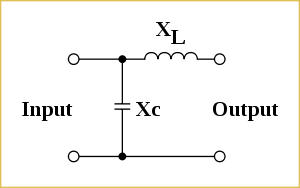
This is called an L network not because it contains an inductor, (in fact some L networks consist of two capacitors), but because the two components are at right angles to each other, having the shape of a rotated and sometimes reversed English letter L. The T (or Tee) network and the Pi (π) networks also have a shape similar to the English and Greek letters they are named after.
This basic network is able to act as an impedance transformer. If the output has an impedance consisting of Rload and jXload, while the input is to be attached to a source which has an impedance of Rsource and jXsource
Then

and

In this example, circuit XL and Xc can be swapped. All the ATU circuits below create this network, which exists between systems with different impedances.
For instance, if the source has a resistive impedance of 50Ω and the load has a resistive impedance of 1000Ω:


If the frequency is 28 MHz,
As,

then, 
So, 
While as, 
then, 
Theory and practice
A parallel network, consisting of a resistive element (1000Ω) and a reactive element (-j 229.415Ω), will have the same impedance and power factor as a series network consisting of resistive (50Ω) and reactive elements (-j 217.94Ω).
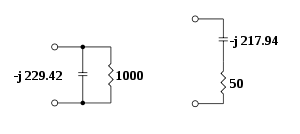
By adding another element in series (which has a reactive impedance of +j 217.94), the impedance is 50Ω (resistive).
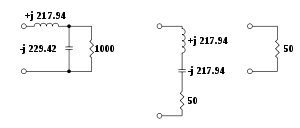
Types of L networks and their use
The L network can have eight different configurations, six of which are shown here. The other two would be seen by exchanging positions of the input and the antenna on the bottom pair of circuits.

The circuits with the series element on the load side are generally used for stepping up to a higher impedance as in the example analyzed above. The circuits with the series element on the input side are generally useful for stepping down to a lower impedance. However this is strictly true only for mainly resistive loads. Where the load is highly reactive, the opposite configuration may be required as is illustrated in the bottom two step down circuits.[5]
There are low- and high-pass versions for the four circuits which use only one inductor and one capacitor. Normally with a transmitter the low-pass would be preferred to attenuate harmonics, but the high-pass configuration may be chosen because the components are more conveniently built, or if attenuation of low frequencies is desirable – for example when a local AM station broadcasting on a medium frequency may be overloading a high frequency receiver.
The Low R, high C circuit is shown feeding a short vertical antenna, such as would be the case in a mobile application or on frequencies below an antenna’s natural resonant frequency. Here the inherent capacity of the antenna is so high that the L-network is best realized with two inductors, instead of adding even more capacitance.
The Low R, high L circuit is shown feeding a small loop antenna. This type of antenna has so much inductance, that more inductance from adding a coil to the circuit is excessive. Therefore the L-network is composed of two capacitors.
Due to the simplicity of the L-network, once a frequency and configuration is chosen (for example, any one of the six above) the component values are uniquely determined. In contrast, the more complex circuits below will have many different solutions, and the designer must exercise judgement in determining final values.
More complex ATU designs
Unbalanced Line Tuners
High Pass T network

This configuration, although capable of matching a large impedance range, is a high-pass filter and will not attenuate spurious radiation above the cutoff frequency as much as the other types. Due to its low losses and simplicity, many home built and commercial manually tuned ATUs use this circuit.
Theory and practice
If a source impedance of 200Ω and a resistive load of 1000Ω is connected (via a capacitor with an impedance of -j200Ω) to the inductor of the transmatch, vector mathematics can transform this into a parallel network consisting of a resistance of 1040 Ω and a capacitor with an admittance of 1.9231 x 10−4 (Xc = 5200Ω).
In the following calculations, all phase angles are expressed in degrees rather than radians. A resistive load (RL) of 1000Ω is in series with Xc -j 200 Ω.

Phase angle 
Y = 1/Z = 9.8058 x 10−4
To convert to a parallel network


If the reactive component is ignored, a 1040Ω-to-200Ω transformation is needed (according to the equations above, an inductor of +j507.32Ω). If the effect of the capacitor (from the parallel network) is taken into account, an inductor of +j462.23Ω is needed. The system can then be mathematically transformed into a series network of 199.9Ω resistive and +j409.82Ω.
A capacitor (-j409.82) is needed to complete the network. The steps are shown here. Hover over each circuit for captions.
-
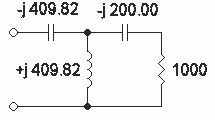
Circuit as seen by user; parts impedance shown on diagram
-

After one transformation (unlabeled part impedance is -j 5200Ω)
-
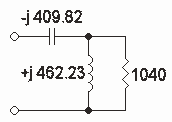
After two transformations
-
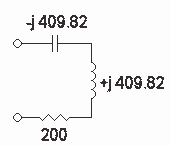
After three transformations
-

After four transformations
Pi network
A pi network can also be used. This ATU has very good attenuation of harmonics, but except for single frequency tuners is not popular, since the variable capacitors are impractically large for the lower Amateur bands.

Ultimate Transmatch
Originally, the Ultimate Transmatch was promoted as a way to make the components more manageable at the lowest frequencies of interest and also getting some harmonic attenuation. It is now considered obsolete; the design goals were better realized with the SPC (series-parallel capacitor) circuit (shown below) which was designed after the name Ultimate was already used. The ultimate transmatch circuit resembles a reversed-direction SPC tuner.
SPC tuner
The Series Parallel Capacitor or SPC tuner can serve both as an antenna coupler and as a preselector.

In the diagram above, the upper capacitor on the right matches impedance to the antenna, and the single capacitor on the left matches impedance to the transmitter. The coil and the lower-right capacitor form a tank circuit that drains to ground out-of-tune signals. The coil is usually also adjustable, in order to widen or narrow the band-pass and to ensure that the ganged right-hand capacitors will be able to both match to the antenna and tune to the transceiver's operating frequency without compromising one or the other.
Balanced line tuners
Balanced (open line) transmission lines require a tuner that has two "hot" output terminals, rather than one hot terminal and ground. Since all modern transmitters have unbalanced (co-axial) output, almost always 50 ohms, the most efficient system has the tuner provide a balun (balanced to unbalanced) transformation as well as providing an impedance match. The tuner usually includes an coil, and the coil can accept or produce either balanced or unbalanced input or output, depending on where the tap points are placed on the coil.
The following balanced circuit types have been used for tuners.

Referring to the diagram at the right, the Fixed Link with Taps is the most basic circuit. The  factor will be nearly constant and is set by the number of relative turns on the input link. The match is found by tuning the capacitor and selecting taps on the main coil, which may be done with a switch accessing various taps or by physically moving clips from turn to turn. If the turns on the main coil are changed to move to a higher or lower frequency, the link turns should also change.
factor will be nearly constant and is set by the number of relative turns on the input link. The match is found by tuning the capacitor and selecting taps on the main coil, which may be done with a switch accessing various taps or by physically moving clips from turn to turn. If the turns on the main coil are changed to move to a higher or lower frequency, the link turns should also change.
The Hairpin tuner[6] has the same circuit, but uses a hairpin (transmission line) inductor. Moving the taps along the hairpin allows continuous adjustment of the impedance transformation, which is difficult with a solenoid coil. It is useful for very short wavelengths from about 10 meters to 70 cm (frequencies about 30 MHz to 430 MHz) where the solenoid inductor would have too few turns to allow fine adjustment. These tuners typically operate over at most a 2:1 frequency range.
Series Cap with Taps. Adding a series capacitor to the input side of the Fixed Link with Taps allows fine adjustment with fewer taps on the main coil. An alternate connection for the series cap circuit is useful for low impedances only, but avoids the taps (For Low Z lines on the diagram).
Swinging Link with Taps. A swinging link inserted into the Fixed Link With Taps also allows fine adjustment with fewer coil taps. The swinging link is a form of variable transformer, that moves the input coil in and out of the space between turns in the main coil to change their mutual inductance. The variable inductance makes these tuners more flexible than the basic circuit, but at some cost in complexity.
Fixed Link with Differential Capacitors. The differential capacitor circuit was used in the classic Johnson Matchbox tuners. The four output capacitors (C2) are ganged, and as the top and bottom caps increase in value the two middle caps decrease in value. This provides a smooth change of loading that is equivalent to moving taps on the main coil. The Johnson Matchbox used a band switch to change the turns on the main and link inductors for each of the five frequency bands available to hams in the 1950s.
Unbalanced tuner and a balun
Another approach to feeding balanced lines is to use an unbalanced tuner with a balun on either the input (transmitter) or output (antenna) side of the tuner. Most often using the popular high pass T circuit described above, with a 1:1 current balun on one side of the unbalanced tuner or the other.
If a balun is placed on the output (antenna) side, the it must be built to withstand high voltage and current stresses, because of the wide range of impedances it must handle.[7] The balun requirements are more modest when if it is put on the input (transmitter) side of the tuner, between the tuner and the receiver, since it operates at a constant impedance, but this introduces complications.
If an unbalanced tuner is fed with a balanced line from a balun instead of directly from the transmitter, then as usual its normal antenna connection – the center wire of its output coaxial cable – provides the signal to the antenna, for one side. However the ground side of that same output connection must feed an equal and opposite current to the other side of the antenna. The antenna and transmitter ground voltages lie halfway between the two “hot” feeds. In order to manage this, the common side (chassis ground) of the tuner circuit must "float", as it will be used to feed one of the hot output terminals.[8] The high voltages present between this floating ground and the transmitter and antenna grounds can lead to arcing and electric shock. To protect the operator and the equipment, the tuner must be enclosed in a cabinet that prevents contact between its floating ground and the other electrical grounds; in particular, the tuner’s metal chassis and its the metal control knobs and surface touched by the operator must all be kept separate from the floating ground of the impedance-matching circuit. This puts difficult constraints on the tuner’s construction.
Z match
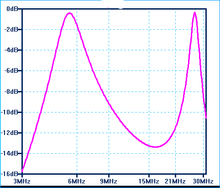
The Z-Match is a widely used ATU in amateur radio.[9][10] This tuner uses a transformer on the output side, and thus can be easily used with either balanced or unbalanced transmission lines. It is limited in power output by the core used for the output transformer. The Z match has two distinct resonant frequencies, enabling it to cover a wide frequency range without switching the inductor.
Antenna system losses
Loss in Antenna tuners
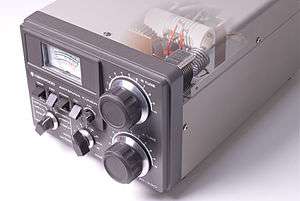
Every means of impedance match will introduce some power loss. This will vary from a few percent for a ferrite cored transformer, to 50% or more for a complex ATU that is improperly tuned or working at the limits of its tuning range.[11]
With the narrow band tuners, the L network has the lowest loss, partly because it has the fewest components, but mainly because it operates at the lowest  possible for a given impedance transformation. With The L network, the loaded
possible for a given impedance transformation. With The L network, the loaded  is not adjustable, but is defined once the source and load impedances are set. Since most of the loss in practical tuners will be in the coil, choosing either the low-pass or high-pass network may reduce the loss somewhat. The L network using only capacitors will have the lowest loss, but this network only works where the load impedance is very inductive, as occurs with a small loop antenna or a wire antenna that is between a quarter and a half wave long.
is not adjustable, but is defined once the source and load impedances are set. Since most of the loss in practical tuners will be in the coil, choosing either the low-pass or high-pass network may reduce the loss somewhat. The L network using only capacitors will have the lowest loss, but this network only works where the load impedance is very inductive, as occurs with a small loop antenna or a wire antenna that is between a quarter and a half wave long.
With the high-pass T network, the loss in the tuner can vary from a few percent – if tuned for lowest loss – to over 50% if the tuner is not properly adjusted. Using the maximum capacity which is available will give less loss than if one simply tunes for a match without regard for the settings.[12] This is because using more capacity means using less inductor turns, and the loss is mainly in the inductor.
With the SPC tuner the losses will be somewhat higher than with the T network, since the added capacity across the inductor will shunt some reactive current to ground which must be cancelled by additional current in the inductor.[13] The trade-off is that the effective inductance of the coil is increased, thus allowing operation at lower frequencies than would otherwise be possible.
If additional filtering is desired, the capacitors can be deliberately set to smaller values, thus providing a band pass effect.[14] Either the high-pass T or the SPC tuner can be adjusted in this manner. The additional attenuation at harmonic frequencies can be increased significantly with only a small percentage of additional loss at the tuned frequency. Note that when adjusted for minimum loss the SPC tuner will have better harmonic rejection that the high-pass T, due to the shunt capacitor. Either type is capable of good harmonic rejection if additional loss is acceptable.
ATU location
An ATU will be connected somewhere between the antenna and the radio transmitter or receiver.[15] The antenna feedpoint is usually high in the air (for example, a dipole antenna) or far away (for example, an end-fed random wire antenna). A transmission line, or feedline, must carry the signal between the transmitter and the antenna. The ATU can be placed anywhere along the feedline: at the transmitter, at the antenna, or somewhere in between.
Antenna tuning is best done as close to the antenna as possible to minimize loss, increase bandwidth and reduce voltage and current on the transmission line. Also, when the information being transmitted has frequency components whose wavelength is a significant fraction of the electrical length of the feed line, distortion of the transmitted information will occur if there are standing waves on the line. Analog TV and FM stereo broadcasts are affected in this way. For those modes, matching at the antenna is required.
When possible, an automatic tuner in a weather-proof case at or near the antenna is convenient and makes for an efficient system. With such a tuner, it is possible to match a wide range of antennas[16] (including stealth antennas).[17][18]
When the ATU must be located between the feedline and the radio for convenience in changing the frequency in use, any significant SWR will increase the loss in the feedline. For that reason, when using an ATU at the transmitter, low loss feedline, such as open wire line is a great advantage. A short length of low loss coaxial line is acceptable, but with longer lossy lines the additional loss due to SWR becomes very high.[19] It is very important to remember that when matching the transmitter to the line, as is done when the ATU is near the transmitter, there is no change in the SWR in the feedline, resulting in higher loss, higher voltage or higher currents, and narrowed bandwidth, all of which are uncorrected.
Standing wave ratio
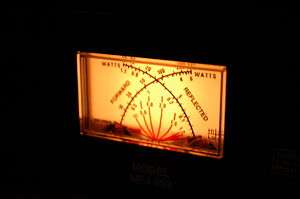
It is a common misconception that a high standing wave ratio (SWR) per se causes loss.[20] An antenna feedline with a high SWR (4:1, for example), when properly configured with an ATU, may have only a small percentage of additional loss compared with an intrinsically matched antenna.[21] The ATU redirects reflected energy (or ‘backlash’) along the feedline and antenna path; additional losses are inherent to the feedline and antenna. SWR causes feedline losses to be multiplied; low-loss feedline has minimal loss with an ATU, but a "lossy" feedline-antenna combination with an identical SWR may have significant loss. A balanced feedline exhibits less loss than coaxial line in the presence of high SWR, so a tuner is primarily used with the former.
Without an ATU, SWR from a mismatched antenna could cause power reflection back to the transmitter; with modern solid state transmitters this causes the transmitter to reduce power to prevent heating and damage to the output stage. Most solid-state power stages perform poorly with an SWR above 1.5 to 1. Were it not for that problem, even an antenna SWR of 2:1 could be tolerated as only 11 percent of transmitted power is reflected and 89 percent is sent forward through to the antenna. Therefore the main loss of output power with high SWR is due to the transmitter automatically ‘backing off’ its output. Tube transmitters usually have an adjustable output network that can feed mismatched loads up to perhaps 3:1 SWR without trouble. In effect the output Pi network of the transmitters is acting as an ATU.
Broadcast Applications
AM broadcast transmitters

One of the oldest applications for antenna tuners is in AM and shortwave broadcasting transmitters. AM transmitters usually use a vertical antenna (tower) which can be from 0.20 to 0.68 wavelengths long. At the base of the tower an ATU is used to match the antenna to the 50 ohm transmission line from the transmitter. The most commonly used circuit is a T network, using two series inductors with a shunt capacitor between them. When multiple towers are used the ATU network may also provide for a phase adjustment so that the currents in each tower can be phased relative to the others to produce a desired pattern. These patterns are often required by law to include nulls in directions that could produce interference as well as to increase the signal in the target area. Adjustment of the ATUs in a multitower array is a complex and time consuming process requiring considerable expertise.
High-power shortwave transmitters
For International Shortwave (50 kW and above), frequent antenna tuning is done as part of frequency changes which may be required on a seasonal or even a daily basis. Shortwave transmitters typically include in their design the ability to match impedances up to 2:1 SWR. Modern transmitters can do this retuning within 15 seconds.
300 ohm balanced transmission lines are more or less standard for shortwave transmitters and antennas, although other values can be found. The transmitter networks incorporate a balun or an external one is installed at the transmitter.
The most commonly used shortwave antennas for international broadcasting are the HRS antenna (curtain array), which cover a 2 to 1 frequency range and the log-periodic antenna which cover up to 8 to 1 frequency range. Within that range, the SWR will vary, but is usually kept below 1.7 to one, thus the transmitter will be able to tune itself as needed to match at any frequency.
See also
- American Radio Relay League
- Electrical lengthening
- Impedance bridging
- Loading coil
- Preselector
- Smith chart
References
- ↑ H. Ward Silver, ed. ARRL Antenna Book. Newington, Connecticut: American Radio Relay League (2011), p. 24-22 ISBN 978-0-87259-694-8
- ↑ http://amfone.net/Amforum/index.php?action=printpage;topic=19648.0
- ↑ P. Branham, A Convenient Transformer for matching Co-axial lines" Cern, Geneva, 1959, http://cds.cern.ch/record/214383/files/p1.pdf
- ↑ Single Stub Match http://www.arcticpeak.com/antennapages/single_stub_match.html
- ↑ Smith, Philip H. (1969). Electronic applications of the Smith Chart, p. 121. Tucker, GA: Nobel Publishing. ISBN 1-884932-39-8
- ↑ H. Ward Silver, ed. (2011). ARRL Antenna Book, p. 24-12. Newington, Connecticut: American Radio Relay League. ISBN 978-0-87259-694-8
- ↑ Hallas, Joel. (2014-09). "The Doctor is in". QST, September 2014, pg. 60. Newington, Connecticut: American Radio Relay League.
- ↑ H. Ward Silver, ed. (2011). ARRL Antenna Book, p. 24-13. Newington, Connecticut: American Radio Relay League. ISBN 978-0-87259-694-8.
- ↑ Salas, Phil, A 100-watt Compact Z-Match Antenna Tuner,http://www.ad5x.com/images/Articles/Ztuner%20RevA.pdf
- ↑ Balanced Line Tuner http://www.qrpkits.com/blt_plus.html
- ↑ Joel R. Hallas. (2010). The ARRL Guide to Antenna Tuners, pg. 4-3. Newington, Connecticut: American Radio Relay League. ISBN 978-0-87259-098-4.
- ↑ H. Ward Silver. (2014). The ARRL Handbook, 2015 Ed., pg. 20-16. Newington, Connecticut: American Radio Relay League. ISBN 978-1-62595-019-2.
- ↑ Kevin Schmidt, W9CF, Estimating T-network losses at 80 and 160 meters
- ↑ Wolfgang, Larry, ed. "Antenna Tuners as Preselectors", Technical Correspondence, QST, September 2015, pg. 61. Newington, Connecticut: American Radio Relay League.
- ↑ http://www.webcitation.org/62nYQYsdn Dave Miller, "Back to Basics". QST, August 1995
- ↑ HF Users Guide (SGC) http://www.sgcworld.com/Publications/Books/hfguidebook.pdf
- ↑ Stealth Kit (SGC) http://www.sgcworld.com/Publications/Manuals/stealthman.pdf
- ↑ Smart Tuners for Stealth Antennas (SGC) http://www.sgcworld.com/Publications/Books/stealthbook.pdf
- ↑ Joel R. Hallas. (2010). The ARRL Guide to Antenna Tuners, pg. 7-4. Newington, Connecticut: American Radio Relay League, ISBN 978-0-87259-098-4
- ↑ M. Walter Maxwell, Reflections: Transmission Lines and Antennas. Newington, Connecticut: American Radio Relay League (1990) ISBN 978-0-87259-299-5
- ↑ Jerry Hall, ed. ARRL Antenna Book. Newington, Connecticut: American Radio Relay League (1988), p. 25-18ff. ISBN 978-0-87259-206-3
Bibliography
- An introduction to Antenna Theory (BP198), H.C Wright. Bernard Babani, London, 1987.
- The Radio communication handbook (5th ed), RSGB, 1976, ISBN 0-900612-58-4.
- Ulrich L. Rohde : "Die Anpassung von kurzen Stabantennen für KW-Sender " (Matching of short Rod-Antennas for short-wave transmitters), Funkschau 1974, Issue 7.
- Ulrich L. Rohde : "Match any Antenna over the 1.5 to 30 MHz Range with Only Two Adjustable Elements ", Electronic Design 19, September 13, 1975